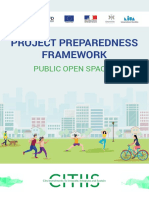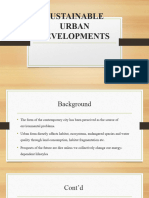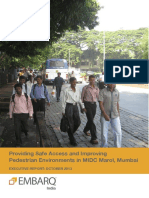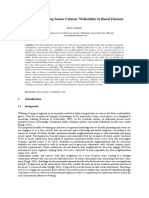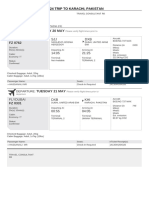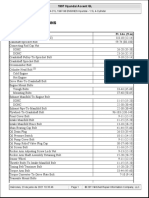0 ratings0% found this document useful (0 votes)
51 viewsChallenges in Nepal
Challenges in Nepal
Uploaded by
Bipana BhujelThe transportation system in Nepal faces significant challenges that hinder its economic growth and social development. Nepal has poor road infrastructure as its rugged terrain makes it difficult and costly to connect remote areas. Additionally, a lack of modern public transportation leads to congestion and pollution issues in urban areas. To address these obstacles, Nepal requires major investments in infrastructure, improved public transit, and innovative solutions to overcome geographical barriers. Taking proactive steps to strengthen transportation could boost Nepal's economy and enhance people's quality of life.
Copyright:
© All Rights Reserved
Available Formats
Download as DOCX, PDF, TXT or read online from Scribd
Challenges in Nepal
Challenges in Nepal
Uploaded by
Bipana Bhujel0 ratings0% found this document useful (0 votes)
51 views4 pagesThe transportation system in Nepal faces significant challenges that hinder its economic growth and social development. Nepal has poor road infrastructure as its rugged terrain makes it difficult and costly to connect remote areas. Additionally, a lack of modern public transportation leads to congestion and pollution issues in urban areas. To address these obstacles, Nepal requires major investments in infrastructure, improved public transit, and innovative solutions to overcome geographical barriers. Taking proactive steps to strengthen transportation could boost Nepal's economy and enhance people's quality of life.
Original Title
CHALLENGES IN NEPAL
Copyright
© © All Rights Reserved
Available Formats
DOCX, PDF, TXT or read online from Scribd
Share this document
Did you find this document useful?
Is this content inappropriate?
The transportation system in Nepal faces significant challenges that hinder its economic growth and social development. Nepal has poor road infrastructure as its rugged terrain makes it difficult and costly to connect remote areas. Additionally, a lack of modern public transportation leads to congestion and pollution issues in urban areas. To address these obstacles, Nepal requires major investments in infrastructure, improved public transit, and innovative solutions to overcome geographical barriers. Taking proactive steps to strengthen transportation could boost Nepal's economy and enhance people's quality of life.
Copyright:
© All Rights Reserved
Available Formats
Download as DOCX, PDF, TXT or read online from Scribd
Download as docx, pdf, or txt
0 ratings0% found this document useful (0 votes)
51 views4 pagesChallenges in Nepal
Challenges in Nepal
Uploaded by
Bipana BhujelThe transportation system in Nepal faces significant challenges that hinder its economic growth and social development. Nepal has poor road infrastructure as its rugged terrain makes it difficult and costly to connect remote areas. Additionally, a lack of modern public transportation leads to congestion and pollution issues in urban areas. To address these obstacles, Nepal requires major investments in infrastructure, improved public transit, and innovative solutions to overcome geographical barriers. Taking proactive steps to strengthen transportation could boost Nepal's economy and enhance people's quality of life.
Copyright:
© All Rights Reserved
Available Formats
Download as DOCX, PDF, TXT or read online from Scribd
Download as docx, pdf, or txt
You are on page 1of 4
CHALLENGES IN NEPAL’S TRANSPORTATION SYSTEM:OVERCOMING
BARRIERS TO SUSTAINABLE DEVELOPMENT
ABSTRACT:
The transportation system in Nepal faces challenges significantly impacting its economic
growth and social development. This report focuses on major obstacles, such as poor road
infrastructure, inadequate public transportation, and challenging geographical terrain. Rugged
landscapes make it difficult to connect remote areas, hampering economic development.
Additionally, lack of modern transportation facilities leads to congestion, safety issues, and
air pollution in urban regions. To address these challenges, Nepal requires significant
infrastructure investment, improved public transportation services, and innovative approaches
to overcome geographical constraints. By addressing such issues proactively, Nepal can
improve its transportation infrastructure, boost economic growth, and enhance the quality of
life for its citizens.
INTRODUCTION
Nepal, a landlocked country characterized by rugged terrains, diverse landscapes, and cultural
richness, has long suffered with the inadequacy and unbalanced distribution of its
transportation infrastructure. This has been a significant obstacle to the nation's economic
development and has contributed to broaden regional disparities. Over the years, Nepal has
experienced political instability, non-inclusive policies, and ethnic conflicts which have
further exacerbated these challenges, making it difficult for some regions to access essential
services and economic opportunities, while other areas experience rapid urbanization and
increased income, demanding a more efficient transport system.
In response to these serious issues, Nepal's government had set significant targets to uplift the
country's economic status and transition from a least developed to a developing nation by
2022. This process required a significant annual economic growth rate, necessitating
significant policy changes and increased investment, particularly in sectors like
transportation.
Transportation is considered the backbone of all infrastructures, and it plays a crucial role in
promoting rapid economic growth. However, the existing transportation system faces
numerous challenges, and thus, this report aims to explore and analyse the existing challenges
and issues in Nepal's transportation sector. It investigates the impact of the uneven
distribution of income across regions, the effects of geographical complexities, and the
consequences of slower development processes. Additionally, the report seeks to identify
policy options and strategies that can address these challenges, boost investment in the
transport sector, and promote sustainable and inclusive economic growth for Nepal.
WHY TRANSPORTATION IN NEPAL IS SO INADEQUATE?
Transportation in Nepal is inadequate primarily due to a combination of geographical
challenges, widespread poverty, increasing car ownership, and adverse weather conditions.
Nepal's unique topography, with both plains and rugged mountainous terrain, makes road
construction and maintenance an arduous task. The difficult terrain not only prolongs
construction time but also results in winding, narrow roads, increasing the risk of accidents.
The country's economic constraints and high poverty rates further increase the transportation
issues. As one of the poorest nations globally, Nepal struggles to invest in developing modern
road networks capable of withstanding weather conditions and efficiently connecting isolated
regions. While private vehicle ownership is on the rise and considered a status symbol, public
transportation remains crucial for the majority who cannot afford personal vehicles. The
transportation infrastructure must adapt to accommodate the increasing number of vehicles
while providing accessible public transport for the less affluent population.
Harsh weather conditions, including monsoons and natural disasters like landslides, adds
additional challenges to transportation in Nepal. These weather conditions can damage
existing roads and prevent the smooth functioning of transportation networks. Remote areas
lacking proper road access face significant hurdles in receiving emergency services and
accessing public facilities, affecting the overall well-being and efficiency of the economy.
Furthermore, the limited availability of all-weather roads severely obstruct the movement of
people and goods, hindering economic growth and development. Approximately 17% of the
rural population in Nepal has access to all-weather roads, indicating a vast portion of the
population remains disconnected from essential services and economic opportunities.
You might also like
- Applied Drilling Engineering Chapter 8 SolutionsDocument99 pagesApplied Drilling Engineering Chapter 8 SolutionsDevbrata Kar50% (2)
- Electronic Ticket Receipt: 618 2433846967: Flight DetailsDocument5 pagesElectronic Ticket Receipt: 618 2433846967: Flight DetailsWai Min ThuNo ratings yet
- Boeing 787-10 Vietnam AirlinesDocument15 pagesBoeing 787-10 Vietnam AirlinesGIANGNo ratings yet
- Brick Township Master PlanDocument192 pagesBrick Township Master PlanTownshipofBrickNJ50% (2)
- Banashree Urban VillagesDocument17 pagesBanashree Urban VillagesBanashree BanerjeeNo ratings yet
- Singapore’s Business Park Real Estate: - Viability, Design & Planning of the Knowledge-Based Urban Development (Kbud)From EverandSingapore’s Business Park Real Estate: - Viability, Design & Planning of the Knowledge-Based Urban Development (Kbud)No ratings yet
- Hans Blumenberg Shipwreck With Spectator Paradigm of A Metaphor For Existence 1 PDFDocument133 pagesHans Blumenberg Shipwreck With Spectator Paradigm of A Metaphor For Existence 1 PDFKiaraNo ratings yet
- Sawp 072 Land Pooling NepalDocument62 pagesSawp 072 Land Pooling Nepalsaroj paudelNo ratings yet
- UNEP Green Cities PresentationDocument54 pagesUNEP Green Cities Presentationgmnew86337No ratings yet
- National Urban Development Strategy NepalDocument116 pagesNational Urban Development Strategy NepalSanyal SaswataNo ratings yet
- Public Open SpacesDocument96 pagesPublic Open Spacesjai digheNo ratings yet
- Infra ReportDocument3 pagesInfra ReportjuniorarkeeNo ratings yet
- Housing and Urban DevelopmentPolicy Issues For 1990sDocument8 pagesHousing and Urban DevelopmentPolicy Issues For 1990sShikafaNo ratings yet
- Sustainable Urban DevelopmentsDocument9 pagesSustainable Urban DevelopmentsTinoNo ratings yet
- Amritsar City Development PlanDocument6 pagesAmritsar City Development PlanJersonFerrerasPuaNo ratings yet
- Transit Oriented DevelopmentDocument6 pagesTransit Oriented DevelopmentParis GeronimoNo ratings yet
- The Evaluation of Waterfront As A PublicDocument8 pagesThe Evaluation of Waterfront As A PublicРадоњић МајаNo ratings yet
- 18 - Oct - 2017 - Pre-Feasibility Report For Development of GardenDocument8 pages18 - Oct - 2017 - Pre-Feasibility Report For Development of GardenHiren H. DoshiNo ratings yet
- Sustainable Communities Case StudyDocument22 pagesSustainable Communities Case StudysankarNo ratings yet
- MIDC Marol Final Exec Report - 10072014 - SS - 0 PDFDocument23 pagesMIDC Marol Final Exec Report - 10072014 - SS - 0 PDFSudhar SunNo ratings yet
- Effective Waste Water System For Kondave Village in Satara DistrictDocument8 pagesEffective Waste Water System For Kondave Village in Satara DistrictIJRASETPublicationsNo ratings yet
- CMP ToolkitDocument23 pagesCMP ToolkitSuheilNo ratings yet
- PG Town PlanningDocument3 pagesPG Town PlanningCharan Reddy100% (1)
- Scoping Study Report HyderabadDocument28 pagesScoping Study Report Hyderabadbharath sandeepNo ratings yet
- Masterlist Environmental FeaturesDocument14 pagesMasterlist Environmental FeaturesvporechaNo ratings yet
- Los Angeles River Revitalization Master Plan, LosDocument12 pagesLos Angeles River Revitalization Master Plan, LosMohd Safwan SaifuddinNo ratings yet
- Kannur Road ReportDocument18 pagesKannur Road ReportDilisha RashaNo ratings yet
- Singapore Bishan ParkDocument33 pagesSingapore Bishan Parkwitanti nur utamiNo ratings yet
- Regional Plan 2021Document6 pagesRegional Plan 2021dasaNo ratings yet
- Urban Flooding-A Case Study of Mumbai CityDocument8 pagesUrban Flooding-A Case Study of Mumbai CityBhavaharini BNo ratings yet
- TCPODocument16 pagesTCPOnitika1chauha-470979No ratings yet
- CDP Jabalpur Copied From SiteDocument181 pagesCDP Jabalpur Copied From SitekanishkgadpaleNo ratings yet
- CS-Curitiba-Brazil-transport-and-zoning-policies PDFDocument2 pagesCS-Curitiba-Brazil-transport-and-zoning-policies PDFBalu SNo ratings yet
- Innovations in Urban Resettlement - Mumbai Urban Transport ProjectDocument16 pagesInnovations in Urban Resettlement - Mumbai Urban Transport ProjectSatya MishraNo ratings yet
- MTMP Preparation Guideline Nepal Municipality1Document2 pagesMTMP Preparation Guideline Nepal Municipality1kishor thapa0% (1)
- Waterfront DevelopmentDocument4 pagesWaterfront DevelopmentJovit JoysonNo ratings yet
- Delhi Master Plan 2021Document33 pagesDelhi Master Plan 2021Ankit Kumar ShahNo ratings yet
- Planning and Development of Urban Settlements in Respect of Spontaneous GrowthDocument20 pagesPlanning and Development of Urban Settlements in Respect of Spontaneous GrowthnymipriyaNo ratings yet
- Gurgaon DrainageDocument3 pagesGurgaon Drainageanuj sethNo ratings yet
- Literature and Case StudiesDocument44 pagesLiterature and Case StudiesNishant ChhatwalNo ratings yet
- Historical OverviewDocument41 pagesHistorical OverviewJim DalmanNo ratings yet
- Regional Development Plan PDFDocument16 pagesRegional Development Plan PDFAlexandra FricosuNo ratings yet
- Readiness of Transit Oriented DevelopmenDocument11 pagesReadiness of Transit Oriented DevelopmenudinNo ratings yet
- Factors Influencing Senior Citizens' Walkability in Rural ThrissurDocument11 pagesFactors Influencing Senior Citizens' Walkability in Rural ThrissurRamiz AkhtharNo ratings yet
- The Urban Regeneration Paris RegionDocument23 pagesThe Urban Regeneration Paris RegionDwitami PuspaningrumNo ratings yet
- Sri Lanka Policies Towards Urban Development Vision Strategy and Initiatives UDADocument30 pagesSri Lanka Policies Towards Urban Development Vision Strategy and Initiatives UDAADBGADNo ratings yet
- Ebenezer Howard (Garden City)Document39 pagesEbenezer Howard (Garden City)megha madhuNo ratings yet
- Jawaharlal Nehru Architecture and Fine Arts UniversityDocument9 pagesJawaharlal Nehru Architecture and Fine Arts UniversityReeshmaNo ratings yet
- Urban Sprawl PDFDocument32 pagesUrban Sprawl PDFAndrei AntonNo ratings yet
- Effects of Land-Use Land-Cover Change On River Flow in Chalimbana River Catchment, Chongwe District, ZambiaDocument10 pagesEffects of Land-Use Land-Cover Change On River Flow in Chalimbana River Catchment, Chongwe District, ZambiaInternational Journal of Innovative Science and Research TechnologyNo ratings yet
- C4C Design Guidelines 2.0Document38 pagesC4C Design Guidelines 2.0ITDP IndiaNo ratings yet
- Study On Transit-Oriented Development (Tod) and MRT: Group-8Document29 pagesStudy On Transit-Oriented Development (Tod) and MRT: Group-8MR LocoNo ratings yet
- 15 Fundamentals of Urban and Regional PlanningDocument1 page15 Fundamentals of Urban and Regional PlanningTpl. Ikiriko Tamunoikuronibo DawayeNo ratings yet
- The Value of Urban DesignDocument4 pagesThe Value of Urban DesignFahmy AtNo ratings yet
- Raj PHED ReportDocument65 pagesRaj PHED ReportSandeep Vaishnav100% (1)
- Urban RenewalDocument43 pagesUrban RenewalAkshi GirdharNo ratings yet
- Urbanization and TransportationDocument16 pagesUrbanization and TransportationVinay KorukondaNo ratings yet
- Key Technical Areas For: Developing Infrastructure ServicesDocument56 pagesKey Technical Areas For: Developing Infrastructure Servicesrajesh0005No ratings yet
- Urbanrenewal 170513105857Document17 pagesUrbanrenewal 170513105857Ankush BhartiNo ratings yet
- Town Planning - TheoriesDocument45 pagesTown Planning - TheoriesVanya AroraNo ratings yet
- Density Guide Book V9LR 0880Document36 pagesDensity Guide Book V9LR 0880Candra Ari SaputraNo ratings yet
- Image of The CityDocument32 pagesImage of The CitySharath M RockzterNo ratings yet
- Presentation of Urban RegenerationsDocument23 pagesPresentation of Urban RegenerationsRafiuddin RoslanNo ratings yet
- Incentives for Reducing Disaster Risk in Urban Areas: Experiences from Da Nang (Viet Nam), Kathmandu Valley (Nepal), and Naga City (Philippines)From EverandIncentives for Reducing Disaster Risk in Urban Areas: Experiences from Da Nang (Viet Nam), Kathmandu Valley (Nepal), and Naga City (Philippines)No ratings yet
- Struktur Organisasi PT GLSDocument1 pageStruktur Organisasi PT GLSIndira Sri ShimaNo ratings yet
- Potomac Aviation, Inc.:, Reagan National Airport - Hangar 7, Washington, DC 20001 USADocument2 pagesPotomac Aviation, Inc.:, Reagan National Airport - Hangar 7, Washington, DC 20001 USAarun RajannaNo ratings yet
- State of Water Transportation in The PhilippinesDocument16 pagesState of Water Transportation in The PhilippinesChatrina MercedNo ratings yet
- UCLA MLP Scavenger HuntDocument1 pageUCLA MLP Scavenger HuntJesus Tapia-VillegasNo ratings yet
- Bus ID No.: E-4580: Total Fare: 1825.00 RsDocument1 pageBus ID No.: E-4580: Total Fare: 1825.00 RsSvRajaNo ratings yet
- Gurps Heavy GearDocument8 pagesGurps Heavy GearfdrmelnkvNo ratings yet
- TicketlDocument3 pagesTicketlsankarrao333No ratings yet
- 17488/TIRUMALA EXP Third Ac (3A)Document2 pages17488/TIRUMALA EXP Third Ac (3A)lalitha bhavaniNo ratings yet
- Road Signage and MarkingsDocument8 pagesRoad Signage and MarkingsNimako MichaelNo ratings yet
- 32 Torque Converter PDFDocument8 pages32 Torque Converter PDFJorge TaffurNo ratings yet
- A Part of Normet CorporationDocument58 pagesA Part of Normet CorporationRodrigo MendizabalNo ratings yet
- Lifting, Moving and Rapid ExDocument13 pagesLifting, Moving and Rapid Expdfs.olpNo ratings yet
- Perception of Transportation A Case Study in BangiDocument83 pagesPerception of Transportation A Case Study in BangiNur SyaNo ratings yet
- UniKL MIAT Piston Quiz 2Document9 pagesUniKL MIAT Piston Quiz 2mellon3duwenNo ratings yet
- Benefit-Cost Analysis of Potential Safety Improvements in Conjunction With 3R ProjectsDocument13 pagesBenefit-Cost Analysis of Potential Safety Improvements in Conjunction With 3R ProjectsRonaldo B VillaromanNo ratings yet
- CQD16, 20 LDocument10 pagesCQD16, 20 LAlex RochaNo ratings yet
- Manual Volvo V70 - 2006Document138 pagesManual Volvo V70 - 2006Dan TifigiuNo ratings yet
- Deloitte - Digitalization in Freight Forwarding - PoVDocument24 pagesDeloitte - Digitalization in Freight Forwarding - PoVr4ndom1zedNo ratings yet
- 12402/Ddn Kota Ac Exp Third Ac (3A)Document2 pages12402/Ddn Kota Ac Exp Third Ac (3A)Jivan singh ChouhanNo ratings yet
- BMW 1 Series Equipment and Technical DataDocument16 pagesBMW 1 Series Equipment and Technical DataasanjurjogNo ratings yet
- ResearchDocument7 pagesResearchDienies Torres100% (1)
- African GemDocument13 pagesAfrican GemAlexander Diete-kokiNo ratings yet
- ESL 1.6.02 OnwardDocument3 pagesESL 1.6.02 OnwardChinh HuuNo ratings yet
- Calculating International Friction Index of A Pavement SurfaceDocument5 pagesCalculating International Friction Index of A Pavement SurfaceOS LaboratoryNo ratings yet
- Hussan Ali Ticits PDFDocument1 pageHussan Ali Ticits PDFtrikala793No ratings yet
- Accent 97 TorquesDocument2 pagesAccent 97 TorquescolectromecNo ratings yet










